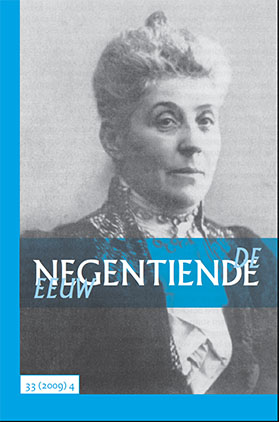Marianne Braun‘Die groote, machtige vereeniging “vrouw”’. De Vrije Vrouwenvereeniging: van civil society naar publieke sfeer 193-212
Abstract (EN)
‘That great, powerful association called “woman”’. The Vrije Vrouwenvereeniging (Free Women’s Association): from civil society to public sphere.This article explores the position of the Vrije Vrouwenvereeniging in Dutch civil society at the end of the nineteenth century. Its scope is confi ned to the group’s early years. This association for the advancement of women was both part of the broader movement for social justice and – because its program was devoted to promoting one sex – an oppositional group inside the movement. Although ‘quiet propaganda’ was the association’s original intention, it soon found itself engaged in political debate and action in the public sphere, partly due to the personality of its president Wilhelmina Drucker.
Wilma van Giersbergen‘Zij hebben er zooveel plaisier in […] dat men eene speld hoort vallen, als de zaal vol is’. Vincent van Gogh en het tekenonderwijs op de Rijks-HBS te Tilburg, 1866-1868 213-236
Abstract (EN)
‘They enjoyed themselves so much […] that one could have heard a pin drop, when the art room was full’. Vincent van Gogh and the drawing lessons at the State High School in Tilburg, 1866-1868.From September 1866 till March 1868 Vincent van Gogh attended the State High School in Tilburg, where Constant Huijsmans gave him lessons in the principles of drawing, including how to use drawing materials and how to in coordinate the hand and eye. Vincent copied geometrical models, fruit, jugs, and fl oral and architectural ornaments and learned the basics of perspective and how to measure proportions. However, when he decided to became an illustrator in 1880, he had yet to learn all the principles of drawing in spite of Huijsman’s lessons on these subjects. Huijsman’s teaching seems to have been lost on the young van Gogh.
Gerard HooykaasHet Koninklijk Instituut en de Koninklijke Akademie 237-247
Abstract (EN)
The Dutch Royal Institute and the Royal Academy of Sciences.In his voluminous study De stem van de wetenschap (The Voice of Science), Klaas van Berkel gives a learned and panoramic view of the Dutch Royal Institute and the Royal Academy of Sciences in the nineteenth century. While the author’s profound analysis is often critical, it is possible to come to quite different conclusions.
Boekzaal der geleerde wereld 248-255
- Lou Spronck, Theodoor Weustenraad (1805-1849) en de ‘Percessie van Scherpenheuvel’. Hilversum: Verloren, 2009. (Joep Leerssen)
- Wouter van der Veen, Van Gogh: A Literary Mind. Literature in the correspondence of Vincent van Gogh. Zwolle: Waanders Publishers / Amsterdam: Van Gogh Museum, 2009 (Van Gogh Studies 2). (Lieske Tibbe)
- Walter A. Buijn, Arabeske of gedachte. Een muziekesthetische tegenstelling in Nederland 1820-1914. Diss. UvA. Amsterdam: Vossiuspers UvA – Amsterdam University Press, 2007. (Ton van Kalmthout)
- Ans. J. Veltman-van den Bos & Jan de Vet, Par Amitié. De vriendenrol van Petronella Moens. Nijmegen: Vantilt, 2009. (Marc van Zoggel)
- Rudo den Hartog, Groet Molletje van mij. Alexander Mollinger (1836-1867), een Utrechtse schilder op de drempel van de Haagse school. Vianen: Optima, 2008. (Lieske Tibbe)

